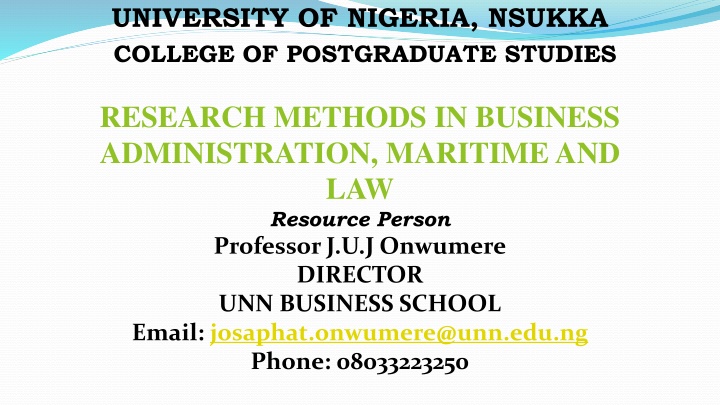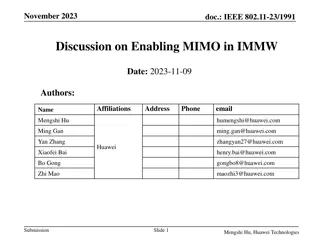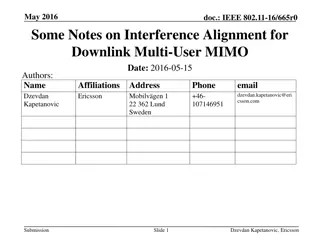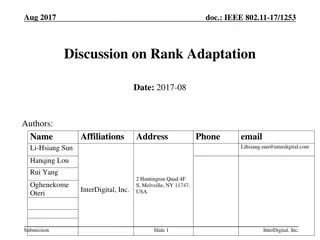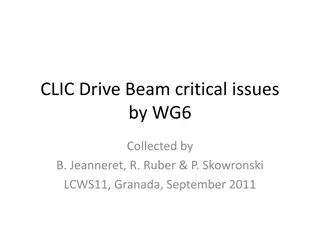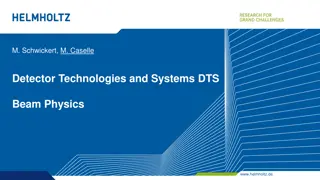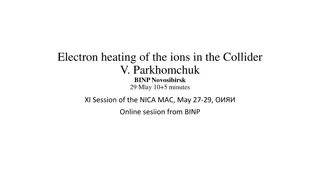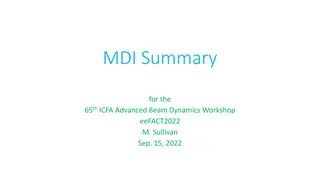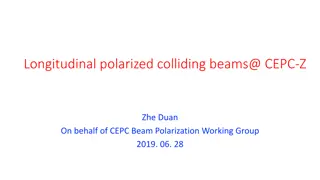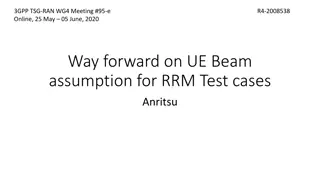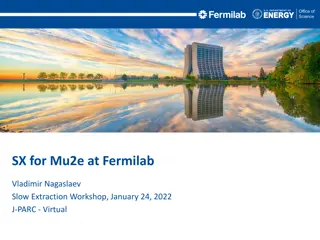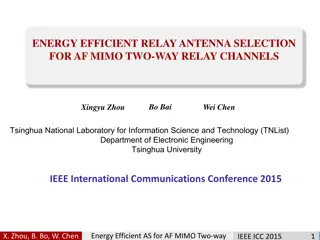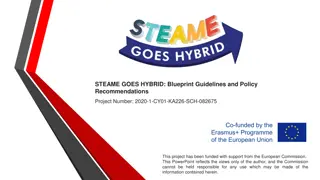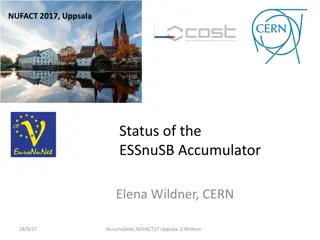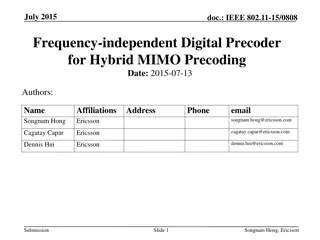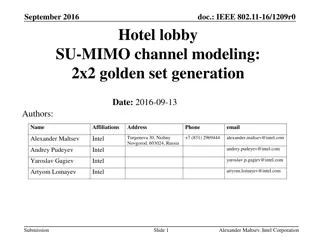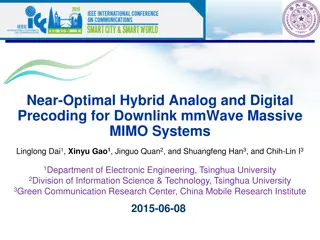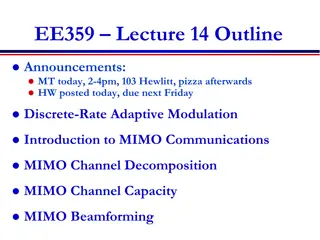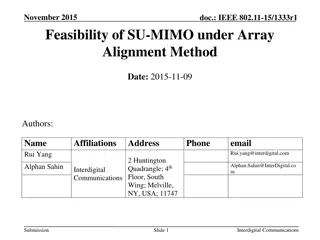Beam Selection for Hybrid MIMO Precoding
Investigating beam selection for hybrid precoding in IEEE 802.11ay with a focus on optimal beam selection based on MIMO modes, simulation results, and implications for performance. The presentation covers hybrid beamforming, motivation, optimal beam selection, and more.
Uploaded on Feb 27, 2025 | 0 Views
Download Presentation

Please find below an Image/Link to download the presentation.
The content on the website is provided AS IS for your information and personal use only. It may not be sold, licensed, or shared on other websites without obtaining consent from the author.If you encounter any issues during the download, it is possible that the publisher has removed the file from their server.
You are allowed to download the files provided on this website for personal or commercial use, subject to the condition that they are used lawfully. All files are the property of their respective owners.
The content on the website is provided AS IS for your information and personal use only. It may not be sold, licensed, or shared on other websites without obtaining consent from the author.
E N D
Presentation Transcript
UNIVERSITY OF NIGERIA, NSUKKA COLLEGE OF POSTGRADUATE STUDIES RESEARCH METHODS IN BUSINESS ADMINISTRATION, MARITIME AND LAW Resource Person Professor J.U.J Onwumere DIRECTOR UNN BUSINESS SCHOOL Email: josaphat.onwumere@unn.edu.ng Phone: 08033223250
OUTLINE 1.0 Goals and Objectives 2.0 Introduction 2.1 Research, its Relevance and Process 2.1.1 Relevance of Research 2.1.2 Research Process 3.0 Structuring a Student s Research Work 3.1 Chapter One: Introduction 3.2 Chapter Two: Review of Related Literature 3.3 Chapter Three: Methodology 3.4 Chapter Four: Data Presentation and Analysis 3.6 Chapter Five : Discussion or Implications of Results 3.7 Chapter Six: Summary of Findings, Conclusion and Recommendations 4.0 Brief Description of Chapter One: Introduction a) The Background to the Study b) Statement of the Problem c) Objectives of the Study d) Research Questions e) Hypotheses of the Study f) Scope of the Research g) Significance of the Study 5.0 Review of Related Literature 6.0 Sources of Literature 7.0 Qualities of a Good Literature Review 8.0 What I Have Learnt from the Workshop 9.0 Summary/Recommendations/Conclusion
1.0 GOALS AND OBJECTIVES Participants are to understand: i. The process of carrying out a research work (participants are postgraduate students), ii. How to explore literature in the area of interest and identify the main problem or challenge or the lacuna or knowledge gap, etc. that has to be investigated, iii. The research questions to be addressed during investigation, iv. The methodology of research, and v. Beyond proposal and analysis; research writing and defence.
2.1 Research, Its Relevance and Process Research has been from several perspectives: Search for the truth about identified problem or challenges and proffering of solutions towards them. A careful or diligent search, studious inquiry or examination, investigation or experimentation aimed at the discovery and interpretation of facts, revisions of theories or laws in the light of new facts (Kerlinger, 1973. p.11)
2.2 Relevance of Research Expose the truth or facts about the area of study Provide relevant solutions for implementation Validate/invalidate relevant existing theories Provide new frontiers of knowledge
2.3 Research Process Identification of the problem or challenge. Choice of topic consequent upon identification of problem. Statement of research objectives, research questions. Doing a literature review. Formulation of hypotheses. Development of good methodology (research design, population and sample determination, data (nature and sources) and collection instrument, models (where necessary), techniques of analysis, etc.). Estimating research cost, providing work schedule. Conducting the research (collecting and collating data as necessary). Carrying out the analysis (which includes hypothesis testing). Doing the report writing. Being student research, defend where appropriate.
3.0 STRUCTURING A STUDENT RESEARCH WORK Generally, a student s academic work, prepared towards satisfying partial requirements for the award of a degree at both the undergraduate and postgraduate levels, may take the form denoted hereunder: Cover page (normally not numbered). Title page. Table of contents. Introduction. Literature Review (or Review of Related Literature). Methodology (or Research Methodology). Data Presentation and Analyses Discussion or Implications of Findings Summary of Findings, Conclusion and Recommendations Bibliography Appendixes The pages where these are to be found should be indicated in the table of contents. Thus, it may be specifically structured into the following chapters:
3.1 CHAPTER ONE: INTRODUCTION 1.1 Background to the Study 1.2 Statement of the Problem 1.3 Research Questions 1.4 Objectives of the Study 1.5 Hypotheses of the Study 1.6 Scope of the Research 1.7 Significance of the Research 1.8 Operational Definition of Terms 1.9 Limitations of the Study
3.2 CHAPTER TWO: REVIEW OF RELATED LITERATURE 2.1 2.2 2.3 Contextual Review 2.3 Theoretical Review 2.4 Theoretical Framework 2.5 Empirical Review 2.6 Review Summary 2.7 Knowledge Gap Conceptual Review Conceptual Framework
3.3 CHAPTER THREE: METHODOLOGY 3.1 Research Design 3.2 Nature and Sources of Data 3.3 Population and Sample Determination 3.4 Description of Research Instruments (where necessary) 3,5 Validity and Reliability of the Instruments (as applicable) 3.6 Model Specification (where necessary) 3.7 Description of Model Variables (as applicable) 3.8 Techniques of Analysis
3.4 CHAPTER FOUR DATA PRESENTATION AND ANALYSIS 4.1 Presentation and Brief Description of Data 4.2 Descriptive Statistics and Preliminary Diagnostic Tests (where or as applicable) 4.3 Data Analysis/Further Tests (where further tests are required) 4.4 Test of Hypotheses
3.5 CHAPTER FIVE DISCUSSION OF FINDINGS 5.1 5.2 5.3 5.4 5.5 General Implications of Results of Hypotheses Tests Theoretical Implications of Results Empirical Implications of Results Policy Implications of Results Discussion of Findings and Research Objectives
CHAPTER SIX SUMMARY OF FINDINGS, CONCLUSION AND RECOMMENDATIONS 5.1 5.2 5.3 5.4 5.5 General Implications of Results of Hypotheses Tests Theoretical Implications of Results Empirical Implications of Results Policy Implications of Results Discussion of Findings and Research Objectives
4.0 Brief Description of Chapter One: Introduction a. The Background to the Study This essentially serves to provide the background environment to the problem, that is, the particular circumstance surrounding the problem without necessarily going into giving very elaborate details or the entire history of the relevant area concerned. It should, therefore, focus on the issues or circumstances surrounding the lacuna, research gap or knowledge gap, or challenge. This is an important section of a research work because it serves as the springboard to the entire exercise at this stage and at the time of actually conducting the research. In this way, it sets the tone for the research proposal, the actual research when conducted and the report writing.
b. Statement of the Problem As the name implies, this elaborates the problem that should necessitate the study in the first instance. This area is very important as without the existence of a problem, or challenge, a study should not be conducted at all. A problem reveals knowledge gap or lacuna that has to be bridged or analysed through research. The knowledge gap may manifest in the form of conceptual distortions, theoretical divergencies, empirical contradictions, methodological deficiencies, data inconsistencies or mutations or irrelevances, flawed conclusions, persistent challenges, un-updated research works (lacking in currency of scope), inadequate geographical coverage (among areas, countries, zones, etc) and other aspects or types of lacuna which needed to be resolved through the current research. A problem is normally associated with conditions that define its existence. These include: 1) The environment in which the problem prevails. Such an environment has its own defining characteristics. 2) The variables within the environment or setting that are associated with the problem. Specifically there might be individuals, households, private/public organizations or governments, or values/cultures, etc. associated with the problem or challenge.
Statement of the Problem Contd. 3) The identified variables might be influencing the problem. In this way, they are endogenous to it or the problem might be endogenous to them. There might also be situations where causation is bi-directional. 4) There must be a corollary, at the least between the researcher s desired search and or outcome and the problem. In other words, the desired objective(s) of the researcher may be situated or achievable within the context of the problem. 5) There is a gap in knowledge, challenge or lacuna which the problem exemplifies or typifies. The implication of this is that some knowledge of the problem exist and are documentable. 6) The issues surrounding the problem are capable of generating questions which research will seek to provide answers to. 7) There is the issue of the significance of the problem in leading to adequate appreciation and understanding of the importance of the proposed research. The significance of the research lies in its ability to resolve the problem. 8) There must be facts revealing the problem. These facts must be up-to-date and accurate and referable i.e. traced to certain reliable sources. These sources could even include authorities in the relevant area who had diagnosed and indicated the problem in their published works. They are evidences, therefore, arising from review of related literature on past researches or authoritative sources that must, of necessity, justify the need for the research and again, the choice of the topic. Statement of the problem may also be presented along the lines of 1. the ideal state (which is prescriptive in nature); 2. the deviation from the ideal (descriptive in nature); and lastly 3. asserting analytically the sorry state of affairs that will arise or currently arising due to deviations from the ideal, hence the necessity and urgency of the study. A problem may equally arise from methodological approaches, and their divergences, or from inappropriateness of variables and data.
C. OBJECTIVES OF THE STUDY In specifying objectives, a researcher should take the following into consideration: a)Intended scope of the study, b)Resources (financial and others) available at his or her disposal, c)Time frame for completing the study; and d)Avoidance of over-ambition and ambiguity (by stating more than necessary objectives that can be achieved). D. RESEARCH QUESTIONS Research questions must, therefore, be: 1. Specific (clearly stated), 2. Directly related to the title of the research, 3. Derived from the problem of the study, 4. Answerable (such that will yield solutions), 5. Fluid in nature (such that it will motivate enquiry and not immediately elicit yes or no answers). Examples are questions starting with How far ?, To what extent ? What are ?, etc. 6. Precise (unambiguous and not lengthy), 7. Serve as guide to the whole study, 8. Exhaustive (in the sense of covering vital issues of the study), and 9. Amenable to empirical tests using data gathered in the process of the research.
E. RESEARCH OBJECTIVES It is normal to state the objectives of a study in operative terms, the essence of which is to give indication at a glance, of the nature of expected tangible outputs. Such terms include the following, among others, depending on the nature of the study: i. To assess . ii. To evaluate .. iii. To investigate iv. To analyse .. v. To compare .. vi. To examine .. vii. To establish . viii. To measure . ix. To describe .. x. To ascertain . xi. To determine . xii. To identify .. xiii. To provide .. xiv. To appraise . Etc.
RESEARCH OBJECTIVES CONTD. Generally, specific objectives must be SMART in order to remain reasonable: 1)Specific: There should be no ambiguity as to its intention. There should be clarity of purpose. 2)Measurable: The variables in it are such that can be measured. 3)Achievable: It must be attainable. 4)Realistic: It makes sense and relates to phenomenon. 5)Time bound(ed): It gives an indication of the period (of time) being assessed or studied.
RESEARCH HYPOTHESES These define the relationship that exists between relevant variables in the researcher s investigation. This relationship could be causal, associational, divergent, comparative, independent, etc. HYPOTHESES OF THE STUDY These define the relationship that exists between relevant variables in the researcher s investigation. This relationship could be causal, associational, divergent, comparative, independent, etc. Hypotheses are thus tentative or probabilistic statements which are yet to be tested (to be tested later). Their verification or otherwise is subject to empirical scrutiny through the conduct of relevant tests. Hypotheses are thus tentative or probabilistic statements which are yet to be tested (to be tested later). Their verification or otherwise is subject to empirical scrutiny through the conduct of relevant tests. They derive from and consequently are extensions of the research questions and objectives of the study. Thus, there has to be synergy between the research questions, the objectives of the study and the research hypotheses. They derive from and consequently are extensions of the research questions and objectives of the study. Thus, there has to be synergy between the research questions, the objectives of the study and the research hypotheses.
SCOPE OF THE STUDY Scope is seen along the following lines: 1) The time period under-studied: For example, it could be at a point in time, t; or for a period of time, t1 to t2. 2) Geography (the area in the world being covered): It could be a local government within a state in a country, a state within a country, a country in an economic zone (e.g. the West African economic community, the South East Economic zone), etc 3) Industry: A particular line of economic activity operating within a particular area which could be a local government, State, country, etc. 4) Firm: A company or organization operating with an industry. 5) Variables: The particular ingredients or units for analysis in the study. 6) Methodology: It might state the approach to be adopted in the analysis without going into details. SCOPE OF THE RESEARCH Scope is seen along the following lines: 1) The time period under-studied: For example, it could be at a point in time, t; or for a period of time, t1 to t2. 2) Geography (the area in the world being covered): It could be a local government within a state in a country, a state within a country, a country in an economic zone (e.g. the West African economic community, the South East Economic zone), etc 3) Industry: A particular line of economic activity operating within a particular area which could be a local government, State, country, etc. 4) Firm: A company or organization operating with an industry. 5) Variables: The particular ingredients or units for analysis in the study. 6) Methodology: It might state the approach to be adopted in the analysis without going into details.
g. Significance of the Study Specifically, it may highlight the following: 1) How and why the outcomes will provide solutions to the problem or challenge that necessitated the study. 2) How the outcomes will be beneficial to certain groups: Here, the individuals, groups or agencies that will benefit from the study are itemized. For each group, it is shown how they stand to benefit. 3) How the study s outcomes will contribute to the body of knowledge in the particular area of investigation: This area is important especially for masters and doctor of philosophy research. At the Ph.D level of research, it is normally expected that the thesis embodies significant contributions to knowledge. The thesis has to be orally defended and significant contributions seen to be true before the examiners can recommend that the degree (Ph.D) be awarded by the relevant university or institution. Most masters degree dissertations or project reports are also orally defended though the level of expectation from them is lower than with Ph.D theses. Candidates are always asked during their orals to state and explain the significant contributions their works have made to knowledge. 4) How the study will contribute to further empirical research in the area of investigation, and to policy making for accelerated development at the local, state, national and regional levels. Also, depending on departments or institutions, this aspect of the research proposal may be divided into two major parts, viz, the practical and academic significance. 1. Practical Significance: Here, it shall itemize those that will benefit from the work (such as managers, policy makers, regulators and the interested public). Under each of these groups, it will be shown how they will benefit from the work. 2. Academic Significance: Here, it shall be shown how the study will contribute from the academic perspective viewpoint. Focus will be on enrichment of the relevant literature from (i) conceptual grounds, (ii) theoretical angles, and (iii) empirical perspectives. OR it be deleanated into different itemised groups and it will be shown how they individually stand to benefit from the study.
BRIEF ON LITERATURE REVIEW OR REVIEW OF RELATED LITERATURE. A good review of literature around a topic should function along the following lines: It must establish why the topic is worth being researched upon. In this respect, it should reveal its importance as it relates to the problem under study as well as within the context of studies undertaken in the past. It will reveal the structure of the problem, the challenge, knowledge gap or lacuna under investigation. A problem may have diverse parts. Literature will identify relevant variables to the topic and problem and also the conceptual and relations issues surrounding them. It provides the researcher with an up-to-date account of relevant theories to his topic of research. It shows evidence of how the relevant theories were applied elsewhere in order to solve the problem under investigation or associated problems. Literature also reveals researches carried out in the past that were directed at solving the current problem or related lacuna. Literature equally reveals the methodologies that had been applied in the past in tackling the problem. The review will show the relevant empirical researches earlier carried out in the area of investigation, revealing the names of the authors of the published works, the methodologies adopted and their findings. In the process of review of related literature, relevant data, especially those of time-series nature, may be gathered by the researcher.
Sources of Literature Main sources of literature or materials to be reviewed include as follows: 1) Publication containing theories in relevant areas of study Information on theories can be easily found (located) in academic journals and textbooks. 2) Conceptual issues can be found in journals and text books and even published conference proceedings. These may be available in soft copies in the relevant internet sites as well as in hard copies (as hard copy published materials). 3) Issues of perception and public opinions and the like can be found in newspapers, magazines, periodicals of varied nature and even through verbal transmissions. The social media have recently become avenues through which people vent out their views. 4) Empirical works (completed and published works) are mainly found in journals and other relevant publications. There are many and varied journal publications in journals. Discussion of empirical works and also often found in text books. 5) Issues of methodology are mainly incorporated in books and researched works in journals. There are also research institutes that publish methods of research investigation which they have evolved over time. 6) Others: Here, we are looking at archival records, narrative correspondences and sundry publications.
Qualities of a Good Literature Review For a literature to be considered good, it must incorporate the following, among others: Discussion must relate to the background and problem statement under investigation (study). We had discussed issues around problem statement much earlier in this chapter. It must identify and discuss the relevant concepts of the study and issues around them including how they contribute to explaining the problem statement. It must incorporate and discuss relevant theories against the background of the topic and problem statement within the context of previous studies. In this respect, some theories may be emphasizing variables of economic and social nature or of even political or psychological nature, however applicable. It should incorporate previous related empirical studies within the context of their methodology (research design, models, techniques of analysis, etc) and findings. It is not uncommon to the many works in economics, management, accounting, marketing and social sciences to produce conflicting evidences or results. In this light, while results emanating from some specific studies might be in agreement with those from some other studies, or their results might be conflicting. Such contradicting results may be as a result of differences in aspects of methodology. Literature should reveal the environments in which earlier related empirical works were carried out. In this respect, it might group the reviewed works using certain criteria. For instance, it might classify them in terms of areas in which they were carried such as emerging economies, developing economies and developed economies. It could be delineated into those from low-income, middle-income and high-income countries. It could also be studies classified as carried out in industrial or non-industrial enclaves within a country. Different types of criteria may be adopted by the researcher in classifying where previous studies were carried out. It should reveal the type and nature of data used in relevant empirical works in some. In many advanced economies, the nature of data is so complex and highly disaggregated. A researcher carrying out similar studies in developing countries may notice, to his dismay, that available data for his may not exist in the disaggregated forms as prevalent in developed economies. At times, the types of data available in the advanced economies may not be available in developing economies. With this exposure form literature, the researcher may have to modify his methodology in order to accommodate the type of data available to him. A good literature review should reveal the types of conclusion reached from previous relevant studies and the recommendation made. It will easily show how the recommendations flowed from the findings. It may also reveal the contributions to knowledge by such researches and gaps or areas that need to be covered.
Further on work structure and other issues Further discussions on methodology, among others (referencing,oral defence, place of ethics in research,etc) : to be more interactively discussed.
ASSIGMENT FOR INTERACTIVE DISCUSSION Group One: Choose a researchable topic and discuss how to research on it. Group Two Choose a researchable topic and discuss how to write a proposal on it.
8.0 WHAT I HAVE LEARNT FROM THE WORKSHOP At the end of this presentation, participants must have understood: The importance of a student s research work. Ability to explore literature in his area of interest and identify the main problem or challenge or the lacuna or knowledge gap, etc. that has to be investigated. Understood research questions to be addressed during investigation and Understood methodology of research. How to go about data analysis. Understood research writing and defence. CONCLUSION THANK YOU
